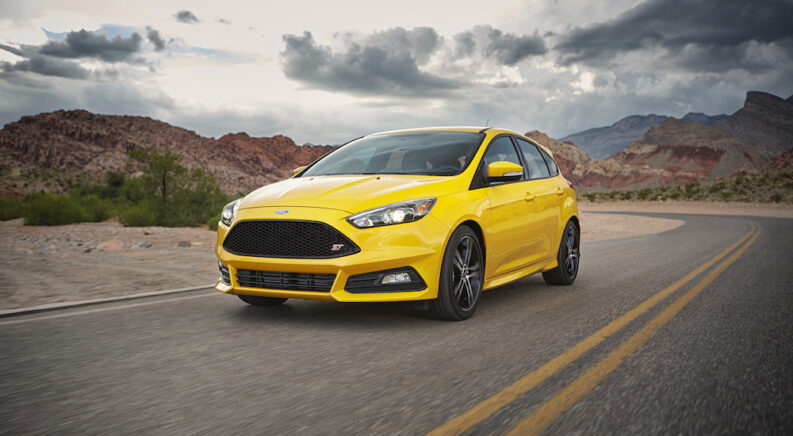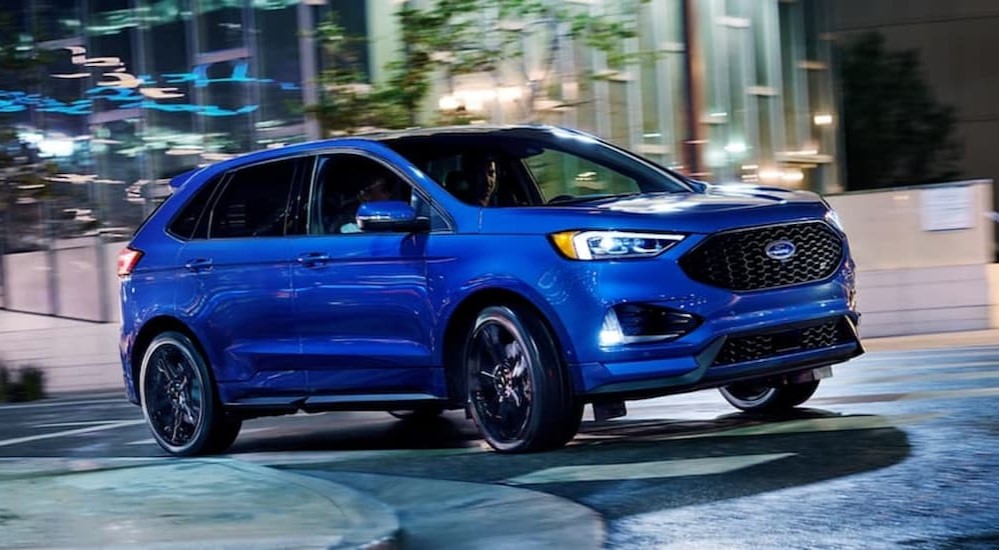If you’ve ever gone to your local Ford dealer and asked about getting something sporty, there’s a good chance you’ve heard about or seen the letters “ST.” Attached to a variety of Fords over the past three decades, the ST has become synonymous with added performance and style in the automotive community; we’re personally fond of the ST trim and how it gives everyday vehicles a dose of fun.
Where did it come from, though? And can you still get Ford ST vehicles today? The short answer to the second question is “yes,” but maybe not in the way you’d expect. Before we get to the long answer, we wanted to take a drive through Ford ST’s history and learn more about its origins…
What Is the Ford ST?
To start, “ST” isn’t just letters that sound cool; it stands for “Sports Technologies,” signifying that any vehicle with an ST badge has received a sport-oriented makeover developed by the Ford Performance division. To be an ST, these models must meet certain parameters for attributes like acceleration and braking, though Ford does not publicly disclose what those parameters are.
The ST badge was conceived by Ford TeamRS (Team Rallye Sport), which was this automaker’s European performance division from 1963 to 2015. Ford TeamRS created many high-performance vehicles over the years, including their series of RS models, such as the Ford Escort RS Turbo and the Ford Sierra Cosworth.
While RS vehicles were rally-inspired (per the name), TeamRS recognized the need for sporty road-focused vehicles, too. In 1997, they debuted the Ford Mondeo ST24 as the first official Sports Technologies model. (Ford TeamRS was later merged with Special Vehicle Team—their North American Counterpart—and Ford Racing to create Ford Performance.)
What About the Ford ST-Line?
Over the years, Ford realized there was a group of drivers who liked the detailing and aesthetics of ST vehicles but still needed a car that was practical and affordable for daily driving. Thus, the ST-Line was born. A Ford with the ST-Line trim has many of the same styling elements as the ST but retains the regular powertrain. In short, ST-Line is a trim level, while ST is a separate vehicle model.
Ford’s ST Series Over the Years
As the car that Ford used for its British Touring Car Championship (BTCC) efforts from 1993 to 2000, the Mondeo (known as the Contour in North America) was a fitting choice for the first Ford ST. While the base-level Mondeo in 1997 had a 125-hp 2.0L four-cylinder engine, the ST24 packed a 2.5L V6 Duratec engine with 167 hp. It also had a sport-tuned suspension, 16-inch aluminum alloy wheels, half-leather luxury bucket seats, and a Rally Sport Appearance Pack, some of which had been available on other Mondeo trims but were now standard on the ST24.
In 1999, Ford added the Mondeo ST200 to the ST lineup, which was identical to the Ford SVT Contour released on North American soil. The engine was beefed up to 200 hp, and the suspension was further refined with MacPherson front struts and multi-link rear for a performance feel.
Both Mondeo ST models were discontinued after 2000, which was the same time the Mondeo/Contour was pulled from the North American market. However, the ST would soon return. The year 2002 brought one more Mondeo special edition overseas—the ST220—as well as the Ford Focus ST170; the latter was a joint venture between the SVT and Special Vehicle Equipment (SVE) divisions. Some of the many Focus ST170 upgrades included a more powerful engine, a Cosworth stainless steel exhaust, bigger disc brakes, and improved steering.
Beginning in the mid-2000s, the Focus and the Ford Fiesta assumed the ST mantel. Every year, an ST edition was produced alongside the non-sport trims—and the differences could be jarring. By way of comparison, the 2017 Ford Fiesta S (base trim) had a 120-hp engine while the 2017 Fiesta ST had a 197-hp engine plus an extra gear in the manual transmission; in other words, you’re talking about the difference between a perfectly fine commuter car and a vehicle that’s ready to put on a show.
These cars weren’t just about power and ego, either; they were fine machines inside and out. When Ford debuted a new generation of the Ford Fiesta ST in 2014, it won more than twenty major awards worldwide, including the Top Gear “Car of the Year,” the Car and Driver “10Best” list, the Esquire Magazine “Small Car of the Year,” and the MotorWeek “Drivers’ Choice Award.” For a period, Ford offered a free one-day lesson at their ST Octane Academy driving school for anyone who bought an ST, helping them develop skills to harness the performance.
Which Fords Are Available as an ST?
Today, two North American Ford vehicles come in an ST model: the Edge and the Explorer. The Ford Focus—which is still sold in the European, Asian, and Australian markets—also retains its ST badging option as well as an ST-Line edition.
The Ford Edge ST first went into production in 2018, replacing the previous Edge Sport; this was the same year Ford announced it was discontinuing all coupes and sedans in North America except the Mustang, thus pulling the Focus ST and Fiesta ST from the market. With the introduction of the Edge ST, Ford thus kept the Sport Touring legacy alive for US and Canadian drivers, doing so through the lens of their increased focus on trucks and SUVs. The Ford Explorer ST followed a year later, giving the ST name a presence in both of Ford’s midsize crossover SUV lineups.
Like with the compact cars before them, the ST crossover variants offer a lot more sugar and spice. The ordinary Ford Edge comes with a turbocharged 2.0L four-cylinder engine with 250 hp and 280 lb-ft of torque; this is perfectly well and good for daily drivers, but if you want to truly have an Edge, the ST bumps things up to a 2.7L twin-turbo V6 with 335 hp and 380 lb-ft of torque. That’s a lot of added pep, getting you more than double the towing power for on-road and light off-road adventuring.
The Ford Explorer ST sees a similar powertrain boost, with the base 300 hp and 310 lb-ft of torque soaring to 400 and 415, respectively. Both ST vehicles have sport-oriented independent front and rear suspensions, 20-inch aluminum wheels (with optional 21-inch wheels), performance brake packages, special exterior accents, and other add-ons to let you and passersby know that what you’re driving is special.
Beyond the new Edge and Explorer, there are plenty of North American pre-owned and Certified Pre-Owned Ford Focus ST and Ford Fiesta ST models from pre-2019. TrueCar currently estimates the price of a 2018 Ford Fusion ST to be anywhere from $12,500 to $28,000, depending on the mileage. If you can get one under the Ford Blue Advantage program, you can be confident you have an ST that’s well-cared for and has a lot of sporty miles left on the odometer.
What’s Next for the Ford ST Name?
It remains to be seen what is to come of the ST in the years ahead. Ford has confirmed they will cease production of the entire Focus nameplate in 2025 due to a combination of declining sales and the shift in priorities we mentioned. For the same reasons, the Ford Fiesta—along with its ST variant—bowed out in 2023.
Furthermore, an all-electric Explorer is on the way, and a report surfaced in late 2023 that the Ford Edge will eventually be replaced by a different electric vehicle, though this may not happen for another three to four years. The ST name has not yet been applied to an electric vehicle, and it’s possible it may eventually have to if it’s to carry on.
For now, though, we’re appreciating the Sports Technologies name and the impact it’s had over the past three decades. If you’ve been waiting to try one, or if you have the same soft spot for ST performance that we do, now is a good time to visit a Ford dealer and see what’s in stock.






